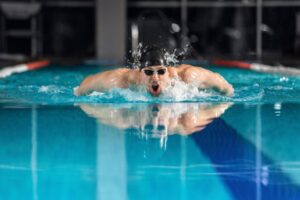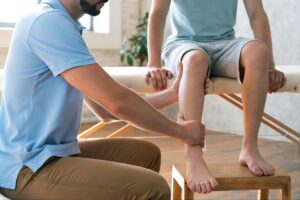Performance in sport depends not only on strength but on the precision of movement. Among elite athletes, the ability to generate power efficiently comes from neuromuscular coordination the body’s ability to activate stabilisers before movers, time motion through the kinetic chain, and sustain balance under load.
Functional Manual Therapy® (FMT™) at VARDĀN ( Advanced Physiotherapy Center, New Delhi) refines this coordination by restoring optimal joint glide, soft-tissue mobility, and timing efficiency. This approach transforms how the nervous system controls motion — improving fluidity, endurance, and overall athletic output.
Why Neuromuscular Coordination Defines Performance
Strength without timing is like a high-powered engine on worn tyres — output without control. In competitive sport, the brain must sequence stability before movement.
If the ribs drift over the pelvis, the shoulder blade lags behind, or the foot collapses on contact, compensations occur. These may present as tightness, heaviness, or recurrent discomfort, but at their core, they reflect timing loss.
Manual therapy restores smooth mechanical input to the nervous system so that motor control can re-establish its ideal sequence. The result is movement that feels lighter, faster, and more efficient.

What manual therapy changes
- Improving joint glide : ensures friction-free motion across all degrees of movement.
- Releasing soft-tissue restrictions : enables proper muscle activation and recruitment.
- Reducing protective guarding : allows stabilisers to engage before prime movers for efficient power transfer.
The FMT pathway from table to field
- Clear the bottlenecks: Targeted joint and soft tissue work restores pain free motion at the exact segments that limit the chain.
- Recode control CoreFirst breathing and alignment place ribs over pelvis and set the shoulder blade and hip so timing returns.
- Reload what matters We add strength and endurance that match your sport while protecting next day comfort.
- Prove it in skills We finish each session by linking the new pattern to your serve, swing, stride or stroke.

Clinical Sport Applications
Tennis
Late scapular rotation and restricted thoracic extension force the rotator cuff to overwork during service.FMT™ mobilises thoracic segments and restores posterior shoulder glide, enabling trunk-driven rotation and efficient shoulder loading.
Result: improved power with reduced arm strain.
Golf
Late scapular rotation and restricted thoracic extension force the rotator cuff to overwork during service.FMT™ mobilises thoracic segments and restores posterior shoulder glide, enabling trunk-driven rotation and efficient shoulder loading.
Result: improved power with reduced arm strain.
Swimming
Neck-dominant breathing and narrow hand entry increase anterior shoulder load.
Restoring rib and thoracic motion and training diaphragmatic breathing with serratus activation improves endurance and reduces impingement.
Result: stronger catch phase and improved rhythm.
Running
Restricted ankle dorsiflexion and delayed gluteal activation contribute to overstriding and tibial stress. Manual therapy frees ankle and hip motion; retraining cadence and trunk control reduces braking forces.
Result: efficient stride mechanics and reduced injury recurrence.
Fast map from common faults to fixes
| Sport pattern that leaks power | Coordination error | Manual therapy focus | Re-education that sticks |
|---|---|---|---|
| Serve loses pace late in matches | Shoulder blade arrives late | Posterior cuff and rib mobility | Scapular setting with thoracic rotation hits |
| Drives irritate the back | Ribs slide over pelvis at top of backswing | Hip and thoracic rotation glide | Anti-rotation holds and tempo swings |
| Freestyle shoulder pinch at tempo | Breath lifts neck not ribs rotate | Rib and thoracic extension with AC joint ease | Diaphragm based breath and early vertical forearm |
| Shin ache after mileage jump | Overstride and delayed hip control | Talocrural and subtalar glide | Cadence increase and hip driven stance work |

A two week coordination reset
- Days 1–4: Restore motion at limiting segments; practice CoreFirst™ alignment in daily activities (sit-to-stand, reach tasks). Keep sport skills light and technical.
- Days 5–10: Build endurance for key stabilisers under steady breathing. Reintroduce sport-specific drills with short intervals and clean form.
- Days 11–14: Progress intensity while maintaining next-day comfort. Extend work sets only if technique and symptom response remain stable.
Clinical Case Insight: Efficiency Without Extra Effort
A recreational runner experienced recurrent calf tightness after 3 km. Assessment revealed restricted ankle dorsiflexion and late trunk engagement at foot strike.
Following manual therapy to restore ankle glide and alignment retraining, cadence was slightly increased and hill strides introduced.
Within one week, the same loop was completed one minute faster at identical heart rate, indicating improved efficiency, not just strength.
Restoring bilateral thoracic rotation, rib mobility, and symmetrical EVF mechanics resolved symptoms and improved efficiency metrics without disrupting training volume.
When to Seek Physiotherapy or FMT™
- Night pain, joint swelling, or sudden “pop” during activity
- Numbness or inability to bear load on a limb
- Recurring discomfort whenever training volume increases
Persistent performance plateaus or recurring niggles often indicate coordination deficits, not just strength gaps and these are correctable through FMT™.
Move better. Perform longer. Enjoy sport.
If you are chasing consistent performance and fewer flare ups, you do not need more grind. You need precision. Request an Appointment for Functional Manual Therapy and a CoreFirst Movement Assessment at VARDĀN, Lajpat Nagar, New Delhi.
Call us today at +91 011 43580720-22 / 9810306730
📅 Book your root-cause consultation at www.vardan.in
📍 Visit our advanced physiotherapy clinic in Delhi in Lajpat Nagar




